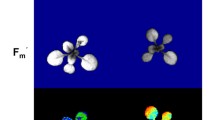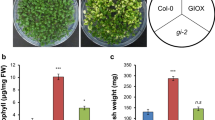Abstract
Several Arabidopsis mutants of the ecotype Dijon were isolated that show resistance to the herbicide acifluorfen, which inactivates protoporphyrinogen oxidase (PPOX), an enzyme of tetrapyrrole biosynthesis. This enzyme provides protoporphyrin for both Mg chelatase and ferrochelatase at the branchpoint, which leads to chlorophyll and heme, respectively. One of the mutations, aci5-3, displays semidominant inheritance. Heterozygous progeny showed yellow-green leaves, while the homozygous seedlings were white and inviable, but could be rescued by supplementing the medium with sugar. Interestingly, the expression of neither of the two forms of PPOX was altered in the mutant, but the rate of synthesis of 5-aminolevulinate, the precursor of all tetrapyrroles, was drastically reduced. Genetic mapping revealed the mutant locus is closely linked to the ch42 marker, which is itself located in the CHLI-1 gene which codes for one of the three subunits of Mg chelatase. The cs mutant also shows a defect in this gene, and test for allelism with aci5-3 confirmed that the two mutations are allelic. Sequencing of the wild type and aci5-3 alleles of CHLI-1 revealed a single base change (G718A), which results in a D240N substitution in the CHLI-1 protein. In the homozygous aci5-3 mutant no CHLI-1 RNA or protein could be detected. Strikingly, CHLH and CHLI-2 transcripts were also absent. This indicates the existence of a feedback-regulatory mechanism that inactivates the genes encoding certain Mg chelatase subunits. The basis for the semidominant inheritance pattern and the relationship between herbicide resistance and modified gene expression is discussed.




Similar content being viewed by others
References
Alawady A, Grimm B (2005) Tobacco Mg protoporphyrin IX methyl transferase involved in inverse activation of Mg porphyrin and protoheme synthesis. Plant J 41:282–290
Beale S (1999) Enzymes of chlorophyll biosynthesis. Photosynthesis Res 60:43–73
Böger P, Wakabayashi K (1999) Peroxidizing herbicides. Springer-Verlag, Berlin
Castelfranco P, Jones O (1975) Protoheme turnover and chlorophyll synthesis in greening barley tissue. Plant Physiol 55:485–490
Choi KW, Han O, Lee HJ, Yun YC, Moon YH, Kim M, Kuk YI, Han SU, Guh JO (1998) Generation of resistance to the diphenyl ether herbicide, oxyfluorfen, via expression of the Bacillus subtilis protoporphyrinogen oxidase gene in transgenic tobacco plants. Biosci Biotechnol Biochem 62:558–560
Chomczynski P, Sacchi N (1987) A rapid and sensitive method of RNA isolation by acid guanidium thiocyanate-phenol-chloroform extraction. Anal Biochem 162:156–159
Cornah JE, Terry MJ, Smith AG (2003) Green or red: what stops the traffic in the tetrapyrrole pathway? Trends Plant Sci 8:224–230
Duke SO, Rebeiz CA (1994) Porphyric pesticides. ACS Symposium Series, vol 559. American Chemical Society, Washington DC
Fischerova H (1975) Linkage relationships of recessive chlorophyll mutations in Arabidopsis thaliana. Biol Plant 17:182–188
Fodje MN, Hansson A, Hansson M, Olsen JG, Gough S, Willows RD, Al-Karadaghi S (2001) Interplay between an AAA module and an integrin I domain may regulate the function of magnesium chelatase. J Mol Biol 311:111–122
Hagège D, Werck-Rechhart D, Schmitt P, Gaspar T (1992) Deficiency in tetrapyrrole-containing compounds in a non-organogenic habituated sugarbeet cell line. Plant Physiol Biochem 39:649–654
Hansson A, Kannangara CG, von Wettstein D, Hansson M (1999) Molecular basis for semidominance of missense mutations in the XANTHA-H (42-kDa) subunit of magnesium chelatase. Proc Natl Acad Sci USA 96:1744–1749
Hansson A, Willows RD, Roberts TH, Hansson M (2002) Three semidominant barley mutants with single amino acid substitutions in the smallest magnesium chelatase subunit form defective AAA+ hexamers. Proc Natl Acad Sci USA 99:13944–13949
Jensen PE, Willows RD, Petersen BL, Vothknecht UC, Stummann BM, Kannangara CG, von Wettstein D, Henningsen KW (1996) Structural genes for Mg-chelatase subunits in barley: Xantha-f, -it g and -it h. Mol Gen Genet 250:383–394
Jung S, Chung JS, Jang SM, Guh JO, Lee HJ, Chon SU, Kim KM, Ha SB, Back K (2003) Either soluble or plastidic expression of recombinant protoporphyrinogen oxidase modulates tetrapyrrole biosynthesis and photosynthetic efficiency in transgenic rice. Biosci Biotechnol Biochem 67:1472–1478
Kjemtrup S, Sampson KS, Peele CG, Hguyen LV, Conkling MA, Thompson WF, Robertson D (1998) Gene silencing from plant DNA carried by a geminivirus. Plant J 14:91–100
Koncz C, Mayerhofer R, Koncz-Kalman Z, Nawrath C, Reiss B, Redei GP, Schell J (1990) Isolation of a gene encoding a novel chloroplast protein by T-DNA tagging in Arabidopsis thaliana. EMBO J 9:1337–1346
Koornneef M, Alonso-Blanco C, Stam P (1998) Genetic analysis. Methods Mol Biol 82:105–117
Kruse E, Mock H-P, Grimm B (1995) Reduction of coproporphyrinogen oxidase level by antisense RNA synthesis leads to deregulated gene expression of plastid proteins and affects the oxidative defense system. EMBO J 14:3712–3720
Kvitko KV (1960) Aseptic culture of Arabidopsis thaliana (L.) Heynh. and its prospective use in botanical studies. Vestn Leningr Univ Ser Biol 15:47–56
Lander ES, Green P, Abrahamson J, Barlow A, Daly MJ, Lincoln SE, Newburg L (1987) MAPMAKER: an interactive computer package for constructing primary genetic linkage maps of experimental and natural populations. Genomics 1:174–181
Lee HJ, Duke MV, Duke SO (1993) Cellular localization of protoporphyrinogen-oxidizing activities of etiolated barley Hordeum vulgare L leaves: relationship to mechanism of action of protoporphyrinogen oxidase-inhibiting herbicides. Plant Physiol 102:881–889
Lee HJ, Lee SB, Chung JS, Han SU, Han O, Guh JO, Jeon JS, An G, Back K (2000) Transgenic rice plants expressing a Bacillus subtilis protoporphyrinogen oxidase gene are resistant to diphenyl ether herbicide oxyfluorfen. Plant Cell Physiol 41:743–749
Lermontova I, Grimm B (2000) Overexpression of plastidic protoporphyrinogen IX oxidase leads to resistance to the diphenyl-ether herbicide acifluorfen. Plant Physiol 122:75–84
Li X, Volrath SL, Nicholl DB, Chilcott CE, Johnson MA, Ward ER, Law MD (2003) Development of protoporphyrinogen oxidase as an efficient selection marker for Agrobacterium tumefaciens-mediated transformation of maize. Plant Physiol 133:736–747
Mochizuki N, Brusslan JA, Larkin R, Nagatani A, Chory J (2001) Arabidopsis genomes uncoupled 5 (GUN5) mutant reveals the involvement of Mg-chelatase H subunit in plastid-to-nucleus signal transduction. Proc Natl Acad Sci USA 98:2053–2058
Mock HP, Keetman U, Grimm B (2002) Photosensitizing tetrapyrroles induce antioxidative and pathogen defense responses in plants. In: Inze D, van Montagu M (eds) Oxidative stress in plants. Taylor and Francis, London and New York, pp 155–170
Muller AJ (1965) On the time period of mutation induction after treatment with N-nitroso-N-methylurea of swelling seeds of Arabidopsis. Mutat Res 2:426–437
Papenbrock J, Mock HP, Kruse E, Grimm B (1999) Expression studies in tetrapyrrole biosynthesis—inverse maxima of magnesium chelatase and ferro chelatase. Planta 208:264–273
Papenbrock J, Mock H-P, Tanaka R, Kruse E, Grimm B (2000a) Role of magnesium chelatase activity in the early steps of the tetrapyrrole biosynthetic pathway. Plant Physiol 122:1161–1169
Papenbrock J, Pfündel E, Mock HP, Grimm B (2000b) Decreased and increased expression of the subunit CHL I diminishes Mg chelatase activity and reduces chlorophyll synthesis in transgenic tobacco plants. Plant J 22:155–164
Porra R, Thompson W, Kriedemann P (1989) Determination of accurate extinction coefficients and simultaneous equations for assaying chlorophyll a and b extracted with four different solvents: verification of the concentration of chlorophyll standards by atomic absorption spectroscopy. Biochem Biochem Biophys Acta 975:384–394
Randolph-Anderson BL, Sato R, Johnson AM, Harris EH, Hauser CR, Oeda K, Ishige F, Nishio S, Gillham NW, Boynton JE (1998) Isolation and characterization of a mutant protoporphyrinogen oxidase gene from Chlamydomonas reinhardtii conferring resistance to porphyric herbicides. Plant Mol Biol 38:839–859
Rissler HM, Collakova E, DellaPenna D, Whelan J, Pogson BJ (2002) Chlorophyll biosynthesis. Expression of a second Chl I gene of magnesium chelatase in Arabidopsis supports only limited chlorophyll synthesis. Plant Physiol 128:770–779
Runge S, van Cleve B, Lebedev N, Armstrong G, Apel K (1995) Isolation and classification of chlorophyll-deficient xantha mutants of Arabidopsis thaliana. Planta 197:490–500
Sambrock J, Frisch EF, Maniatis T (1989) Molecular cloning: a laboratory manual, 2nd edn. Cold Spring Harbor Laboratory Press, Cold Spring Harbor
Spikes JD, Bommer JC (1991) Chlorophyll and related pigments as photosensitizers in biology and medicine. In: Scheer H (ed) Chlorophylls. CRC Press, Boca Raton, pp 1181–1204
Strand A, Asami T, Alonso J, Ecker JR, Chory J (2003) Chloroplast to nucleus communication triggered by accumulation of Mg-protoporphyrin IX. Nature 421:79–83
Susek RE, Ausubel FM, Chory J (1993) Signal transduction mutants of Arabidopsis uncouple nuclear CAB and RBCS gene expression from chloroplast development. Cell 74:787–799
Walker CJ, Willows RD (1997) Mechanism and regulation of Mg-chelatase. Biochem J 327:321–333
Watanabe N, Takayama S, Yoshida S, Isogai A, Che FS (2002) Resistance to protoporphyrinogen oxidase-inhibiting compound S23142 from overproduction of mitochondrial protoporphyrinogen oxidase by gene amplification in photomixotrophic tobacco cells. Biosci Biotechnol Biochem 66:1799–1805
Yaronskaya E, Ziemann V, Walter G, Averina N, Börner T, Grimm B (2003) Metabolic control of the tetrapyrrole biosynthetic pathway for the porphyrin distribution in the barley mutant albostrians . Plant J 35:512–522
Author information
Authors and Affiliations
Corresponding author
Additional information
R. Herrmann
O. Soldatova and V. Ziemann contributed equally to this work.
Rights and permissions
About this article
Cite this article
Soldatova, O., Apchelimov, A., Radukina, N. et al. An Arabidopsis mutant that is resistant to the protoporphyrinogen oxidase inhibitor acifluorfen shows regulatory changes in tetrapyrrole biosynthesis. Mol Genet Genomics 273, 311–318 (2005). https://doi.org/10.1007/s00438-005-1129-6
Received:
Accepted:
Published:
Issue Date:
DOI: https://doi.org/10.1007/s00438-005-1129-6




